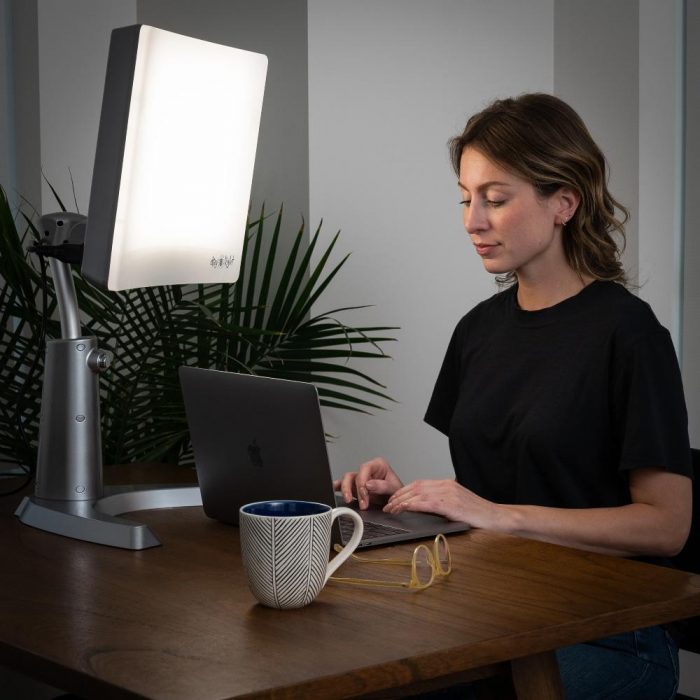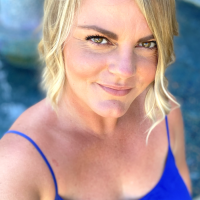This article is written in partnership with Carex. They’re dedicated to brightening days by bringing dignity back into people’s lives through self-care medical products—bright light therapy in this case. We are honored to work with them ~ ed.
~
“Why in the world would you move from a tropical paradise to the mountains in the winter, just as it’s getting cold?”
Friend after friend asked me this as I told each of them about my impending return to the mainland from Hawai’i.
After a year of constant 70s-or-above weather, I was actually looking forward to drinking a pumpkin spice latte in a sweater instead of a tank top. I looked forward to knit hats, wool socks and booties, the cold kiss of the wind lingering on my cheek. I even looked forward to snow.
And then reality began to dawn on me:
Kona, Hawaii sunrise: 6:30 a.m.
Kona, Hawaii sunset: 6:00 p.m.
Leavenworth, Washington sunrise: 7:30 a.m.
Leavenworth, Washington sunset: 4:00 p.m.
That’s a three-hour loss of sunlight.
The worst months for SAD are January & February. Be happier during them—with 15% OFF (use code EJ15). >>
The reason so many people were asking about the presumably harsh transition is because it’s legitimately a challenge for our bodies to make such a change.
Some SAD numbers
About 10 million Americans suffer from Seasonal Affective Disorder (SAD) (1), a form of depression that usually begins around the late fall or early winter as the amount of light we are exposed to begins to dwindle. Three out of four SAD sufferers are women, and a majority of them suffer these “seasonal” symptoms for 40% of the year:
>> Feeling depressed a majority of the day, most days of the week
>> Loss of interest in activities
>> Changes in appetite or weight
>> Problems with sleep
>> Feeling sluggish, agitated, and low on energy
>> Feeling hopeless and worthless
>> Difficulty concentrating
>> Frequent thoughts of death/suicide
And according to our friends over at Carex, a 35-year leader in in-home, self-care medical products designed to help bring dignity back into people’s lives, in the case of Winter Pattern SAD specifically, the most common, tell-tale signs that we might be experiencing SAD are oversleeping, overeating (particularly carbs), weight gain, and social withdrawal (2).
Oof! That’s heavy stuff—and way too relatable, right? I mean, I feel that. Deep down in my gut, I feel it.
While I haven’t ever been diagnosed with SAD, the last time I made a similar move from sunny Southern California to the base of the Rocky Mountains in Colorado, I struggled hardcore with depression, anxiety, and isolation during my first winter.
And now, here I am, making a trans-Pacific move from one of the three states with the sunniest winters (6) back to the base of the wintry Rocky Mountains.
Now, I know the way I process stress, and I knew I didn’t want to ride the same ol’ heart-pounding, adrenaline-rushing rapids of change—nonetheless compounded by seasonal stress. I needed to bring the light of Hawaii home with me, and I knew it.
Don’t let seasonal stress darken your days! Get that much-needed, healing light—right at home >>
The Bright Side
“The sunlight was so beautiful this morning, wasn’t it,” my mother asked while showing me a photo of gorgeous golden light showering her downstairs wall.
I quickly nodded my head only to stop abruptly, realizing it was (1) raining outside and (2) still dark.
“That’s from your lamp,” my mom said.
I’d just finished a 20-minute light bath in front of my Carex Day-Light Classic Plus lamp up in the tiny loft space of my mom’s place and was feeling so zen, I had for a moment truly believed it was a beautiful, sunny day.
When it comes to creating that sunny day feel to help us combat the weight that might come from the changing of the seasons, that’s something Carex is an expert in. They make lamps specifically designed to help us combat our full-tilt clinical SAD, more mild “winter blues,” and anxiety by helping us gain exposure to light that mimics the quality of the sun’s rays in its absence.
And it’s not new. In fact, it’s been around for quite some time. Light therapy gained recognition as a viable therapy in the 1980s. Since then, it’s become the first-line treatment for SAD, with the proper bright light therapy exposing a patient to at least 10,000 lux of light for a recommended 20 to 30 minutes each day. And it’s got some powerful results.
A review article published in 2005 by Mount Sinai School of Medicine collected and reviewed various studies of light therapy and its effects on non-seasonal depression. The review found that bright light therapy works—so well, in fact, that it was found to achieve what antidepressant drugs did in as little as one week compared to 4-16 weeks. (7)
“Turn up the energy, please”: See if Carex’s clinical-strength light-therapy lamps are for you >>
During the spring and summer, adequate exposure to the sun tends to provide us with the vitamins (especially vitamin D) and hormones we need to function mentally and physically. This is particularly true when it comes to our sleep-wake cycles.
Sunlight helps our brain to produce both serotonin and melatonin, hormones that respectively wake us up and put us to sleep. When we have enough of each in our bodies our circadian rhythms sync, providing us with restorative, healing balance.
Carex’s bright light therapy lamps emit bright light that simulates outdoor sunshine allowing us to reap the benefits of sunshine—even if we’re in Nome, Alaska rather than Kona, Hawai’i. And the benefits can be noted within the first few sittings. When most of the 40 million cells in our brains are impacted by serotonin, including our moods, that’s no small feat.
I’ll admit that when I read that most people start seeing improvements that soon, I was a bit skeptical, but I can personally attest to this being the case.
Make like Aladdin: Take this quiz to be paired with your perfect “magic” lamp. Get 15% off using code EJ15. >>
I started turning on the lamp first thing after doing some yoga in bed. I bathed in the light set up just as instructed and journaled for 20 minutes each morning. Usually a pretty groggy, slow-to-rise person who wakes up with anxiety, the light roused me faster and more genuinely than a triple shot of espresso and had me feeling alert and centered throughout the day.
Bed time? Effortless—if not a bit too early. Rising and taking my light bath at 5:45 a.m. meant that my brain said bed time was at 7:30 p.m.—more than three hours after it gets dark up here in the Pacific Northwest.
I’m not the only one who’s experienced fast and noticeable effects, either. My co-worker tried the lamp at the same time as me and had similar results to share when I asked her for a review:
“I want to start this off by saying that I am just so freakin’ grateful for this miracle device. It’s never leaving my bedside.
Look, I’m not living under a rock in the dark 24-7, but I’m a California girl who has been transplanted to Colorado and I sit inside 8 hours a day, 5 days a week. So, I guess you could say I’m the perfect candidate for needing some more rays.
Over the last few weeks, I have gotten up, gone straight over to my little sun lamp and sat there for 15 minutes. It’s become a routine more sacred than my morning coffee. In fact, weirdly enough, I’ve also found myself with fewer “I neeeeeed my morning (and mid-day) coffee” moments.
I haven’t ever been diagnosed with SAD, but I definitely struggle during these months, and so far, the lamp has helped me feel more…well, alive. I feel more rested when I wake up, more energized throughout the day, and I don’t feel this overall emotional heaviness as much as I normally do. (By the way, this is an even bigger deal due to the fact that I am in the middle of juggling a move, an out-of-state wedding, holidays, a new job, and an anxiety-ridden dog.)
It kind of feels like I’ve been super-dosing vitamins, except I don’t have to do anything besides sit there (which my tired soul loves).
In my opinion, if anyone needs an emotional and physical recharge, this is the easiest and quickest way to get there.” ~ Kate Force, Ed.
Follow the Sun (and the recommended doses and extras)
There’s a couple more things you should know before you show yourself a little extra lovin’ and reach out to Carex to order the perfect light therapy lamp for your needs.
Quiz time: Which light therapy lamp is for you? >>
There’s no one cure-all for things like SAD—and Carex is the first to acknowledge that, which I love as a consumer. As human beings, we so often tend to look for the quick fix, and there really is no such thing. So we order objects thinking they’ll magically solve our issues. But we always need to do the work.
As long as you work it—consistently, and alongside other health and wellness practices that aid in serotonin production—bright light therapy works to do more than improve our sleep patterns and SAD.
There are plenty of additional benefits born from serotonin and melatonin production, including:
Increased focus, learning & productivity: According to Harvard Health Publishing, “constant fatigue can make you less mentally and physically active, hamper cognitive function, and diminish overall quality of life.” When you reduce the constant fatigue and depression, via balanced serotonin levels, you increase your ability to learn.
Improved memory: A 2017 John Hopkins study of the brain showed that those with a declined memory and conditions such as Alzheimer’s disease have a severe decrease in serotonin neurons. Increasing serotonin levels, may help reduce memory decline.
Reduced anxiety: While melatonin is primarily known for regulating sleep, it’s been shown to reduce anxiety, and multiple studies have shown light treatment for anxiety to be effective.
More regulated digestion and appetite: Having a healthy amount of serotonin aids in regular bowel function and reduces appetite as we eat. Many studies have shown light therapy to be effective in helping treat those with eating disorders.
Faster, more efficient healing: After cutting ourselves, our blood platelets release serotonin to aid in healing the wound. Serotonin causes arteries to narrow and help form blood clots.
It’s Time to Heal
Combining bright light therapy with other practices such as exercise, eating healthy, and wellness can make a significant difference in one’s mental wellbeing, physical fitness, and overall quality of life.
So establish a morning routine that makes room for 30-minutes of light bathing within an hour of waking, prepare to hydrate and tap into some of the many other ways to boost serotonin in our bodies, and bask in the literal light of healing.
Bask in the literal light of healing & make it your new self-care regimen—at 15% off using code EJ15. >>
~
~
Resources:
(1) Boston University
(2) Carex.com
(3) EPA.gov
(4) SleepHealth.org
(5) National Library of Medicine
(6) Carex.com
(7) Carex.com




Read 5 comments and reply